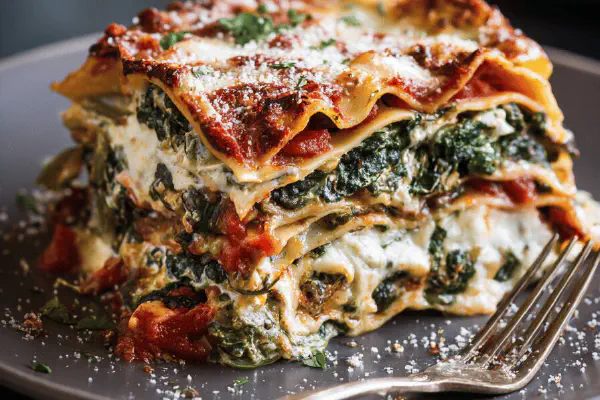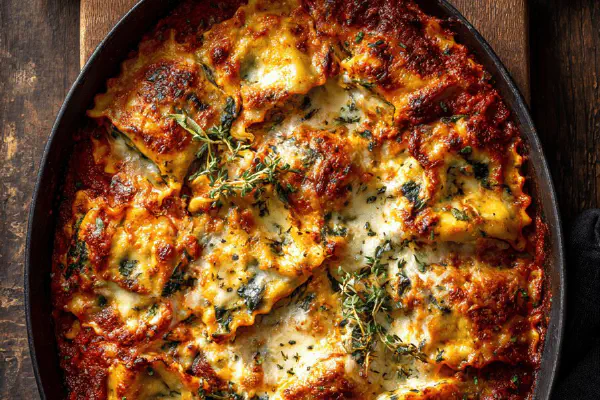Spinach Ricotta Lasagna Revamp

E
By Emma
Certified Culinary Professional
•
Recipe tested & approved
Ricotta and spinach layers in a homemade tomato sauce with oregano replaced by thyme, lasagna sheets swapped for whole wheat, finished with smoked gouda and pecorino cheeses instead of parmesan and mozzarella. Cream replaced by whole milk. Cook times shifted slightly to catch all bubbling and browning right. Added a touch of lemon zest to brighten the filling. Leaves you with a hearty, creamy yet slightly tangy bake. Vegetables wilted not mushy, sauce thick enough to cling but not drown. A bit rustic, a bit sharp. Works well frozen at the assembly stage. Ready for a weekend project or a weeknight rescue.
Prep:
50 min
Cook:
40 min
Total:
Servings:
6 servings
#Italian
#lasagna
#spinach
#ricotta
#whole wheat
#smoked gouda
#baking tips
Ricotta and spinach, always a classic but comfortably tweaked here. Thyme sneaks in place of oregano, lending a woodsy warmth — I found oregano too straightforward in previous tries, a tad one-note. Whole wheat noodles swap out standard for a nuttier bite, plus bonus fiber. Smoked gouda and pecorino replace mozzarella and parmesan — a bolder, smokier edge that cuts the creaminess clean. A dash of lemon zest woke the filling; past attempts felt flabby, lacking brightness. Sauce simmers steadily, thickening to that glance-back-you-know-it-when-you-see-it stage — no drainout. Baking covered traps steam, ensures noodles cook fully without fuss. Uncovered finish crisps cheese, brings texture contrast you miss when skimping. Resting crucial or serving gets messy. Freeze after assembly if time’s tight — the easiest trick for meal prep that doesn’t betray flavor. Sit back. Wait for bubbling and crust, dig in.
Ingredients
Tomato Sauce
- 1 medium onion finely chopped
- 2 cloves garlic minced
- 45 ml olive oil
- 2 cans 796 ml Italian crushed tomatoes
- 2.5 ml dried thyme
- Salt and pepper to taste
Filling
- 400 g baby spinach
- 30 ml olive oil
- 400 g ricotta cheese
- 65 g smoked gouda finely shredded
- 60 ml whole milk
- Freshly grated nutmeg, just a pinch
- Zest of 1 small lemon
- Salt and pepper to taste
Assembly
- 15 whole wheat lasagna noodles cooked al dente, lightly oiled
- 200 g pecorino romano shredded
- 150 g smoked gouda shredded
About the ingredients
Spinach moisture is critical. Cutting corners by skipping draining leads to soggy layers — a pitfall I’ve learned to avoid by squeezing handfuls tightly in sieve or pressing with ladle. For cheese, smoked gouda adds complexity instead of plain mozzarella, bring temptation where parmesan alone wouldn’t. Ricotta should be whole milk type for creaminess; low-fat dries the filling out. Milk substituted for cream lightens mouthfeel but keeps moisture balance—don’t overdo or mix gets runny. Thyme’s subtle but strong aroma shifts flavor profile comfortably; if absent, marjoram or basil make fine backups. Whole wheat pasta holds better in freeze-thaw cycles, no mush if cooked just right. Keep noodles lightly oiled so they don’t glue together during assembly — a kitchen-saved frustration. Fresh lemon zest over dry — bright pungency keeps filling lively rather than choking richness. Salt cautiously to account for cheese saltiness. Olive oil quality influences sauce aroma; don’t skimp.
Method
Sauce
- 1. Heat olive oil in a medium saucepan on medium until shimmering. Add onion and garlic. Stir, hear gentle sizzling, the scent awakening the kitchen. Fry until translucent, about 6 minutes, edges just turning golden. Toss in crushed tomatoes and thyme. Bring to a lively boil. Reduce and simmer actively, sauce thickening, color deepening, 18 to 20 minutes. Taste for salt and pepper. Sauce should coat the back of a spoon, not watery, but still vibrant. Remove from heat; set aside.
Filling
- 2. While sauce simmers, warm olive oil in a large skillet over medium-high heat. Toss in spinach, sprinkle in a pinch of salt, stir quickly – spinach wilts, darkens, and shrinks within 3 minutes. Hear the soft hiss as moisture escapes. Scoop spinach into a fine-mesh sieve and press firmly to eject excess liquid, or spinach will make filling soggy. Let cool enough to handle. Roughly chop for texture; too fine and you lose the bite.
- 3. In a bowl, fold chopped spinach with ricotta, smoked gouda, milk, nutmeg, and lemon zest. Salt and pepper now, mindful that cheeses add saltiness. If mixture feels dry, splash in a bit more milk — supple but not runny. Taste — a hint of freshness from lemon keeps it lively. Set aside.
Assembly
- 4. Preheat oven to 185 °C (365 °F). Arrange oven rack in middle position. Oil your baking dish lightly to prevent sticking and burning edges.
- 5. Spoon 200 ml of sauce on the bottom, spreading evenly. Layer 5 lasagna noodles side by side, overlapping slightly to seal. Ladle 350 ml sauce over noodles, scatter 25 g pecorino and 35 g smoked gouda evenly. Dollop half the spinach ricotta mix, spread to edges for consistent bite and bake. Repeat layering: noodles, sauce, pecorino and gouda, remaining filling. Final layer: noodles, remaining sauce. Cover top with remaining cheeses.
- 6. At this point, cover tightly with foil for baking or freeze for later use. If frozen, thaw overnight in fridge before baking. Baking covered traps steam, cooks noodles and melds flavors gently.
- 7. Bake covered for 35 minutes until bubbling and edges start to brown lightly. Remove foil; increase heat slightly or switch to broil for 4 to 6 minutes until cheese browns to a golden crust. Watch carefully to avoid burning. Look for cheese melting, bubbling, some blistering for texture contrast.
- 8. Let rest 15 minutes post-baking to firm up layers and avoid hot cheese spurts. Cut with a sharp knife for clean slices or messy rustic chunks, your call.
Tips and Tricks
- Spinach moisture is killer on texture — dry well. Use a cheesecloth if you don't have a sieve. Milk instead of cream makes filling lighter and less greasy. Thyme swapped for oregano — change the herbal note to earthier warmth. Smoked gouda and pecorino add depth and a bit of bite missing from bland mozzarella and parmesan combo. Whole wheat noodles add nuttiness and keep things hearty. Lemon zest is my secret kick — brightens creamy ricotta filling, cuts heaviness. Oven temps vary so rely on bubbling signals and crust color, not just timers. Let it rest or it’ll ooze mess. Freeze at assembly to save time; just don't skip thawing slowly or noodles get stiff. If sauce too acidic, pinch sugar or use a small grated carrot in cooking stage to balance.
- Common mistake: rushing spinach draining or sloppy layering. Results in watery lasagna or collapsing layers. Use sturdy baking dish; glass or ceramic absorbs heat evenly, avoids burnt bottoms. For speed, pre-cooked noodles are a godsend, but must be well separated with oil to avoid clumps.
- Serve with something sharp or acidic — a simple vinaigrette salad or pickled veggies cut richness. And wine? An earthy red or robust white works — just don't overthink it.
Cooking tips
Starting softening onions and garlic until translucent is your flavor baseline — the usual hard bit is skipping this and ending with flat sauce. The bubble-and-reduce stage thickens and concentrates acids, controlling bright but harsh tomato notes, so simmer till sauce paints-spoon-thick. Spinach wilting needs quick heat and seasoning inside the pan; long cooking for erasing freshness — just enough to wilt, then press immediately to prevent watery filling. I’ve failed many times here by rushing— soggy filling was a giveaway. Folding cheeses and zest last prevents overmixing, which breaks textures. Assembly in layers shapes moisture distribution and support; too sparse sauce leaves dry edges, too heavy makes it sloppy. Baking covered carefully traps steam for perfect noodle cooking; uncovered finish crisps cheese, avoid burning by keeping an eye during broil phase — a couple minutes too long turns it bitter. Ten-fifteen-minute resting cool down lets lava cheese re-solidify — skipped this and burnt mouths almost happened. For freezing, freeze fully covered and thaw slowly; reheating directly causes toughness. Watch visual cues more than exact times — bubbling, cheese color, edges firming signal doneness better than clocks.
Chef's notes
- 💡 Spinach drains critical. Skip squeezing = soggy filling. Use sieve or cheesecloth. Press hard or liquid ruins texture. Chop roughly, keep bite. Too fine turns mushy in bake.
- 💡 Oven cues better than timers. Bubbling sauce thickens, edges start to brown. Foil keeps steam trapping noodles cooking gentle. Remove foil last minutes to crisp cheese top.
- 💡 Milk instead of cream. Keeps filling lighter, less greasy, but not dry. Add splash carefully. Too much = loose filling, too little = chalky texture. Cheese saltiness requires cautious seasoning.
- 💡 Layer evenly. Noodles overlap slightly to seal, prevent sauce leakage. Sauce thick enough to coat spoon but not heavy. Thin sauce = collapse. Thick sauce = dryness. Balance vital.
- 💡 Use fresh lemon zest not dried. Adds brightness that cuts heaviness. Zest last, fold gently. Thyme replaces oregano with woodier aroma. Backup with marjoram or basil if missing.
Common questions
How to prevent soggy spinach filling?
Drain well. Press firmly with sieve or cheesecloth. Chop roughly. Do not overcook spinach wilt fast. Excess moisture kills texture, makes filling runny.
Can I substitute cheeses?
Pecorino and smoked gouda bring smoky, sharp notes. Use parmesan or mozzarella but lose that edge. Creamier filling without gouda. Adjust salt accordingly.
Why cover during baking?
Foil traps steam. Cooks noodles fully. Stops drying edges. Uncover last 5 minutes to brown cheese top. Skip uncover step, cheese stays pale, lacks texture contrast.
What’s best storage method?
Freeze layered lasagna covered tightly. Thaw overnight in fridge. Bake from cold or room temp. Refrigerate leftovers in airtight container up to 3 days.



